No products in the cart.
Table of Contents
The Begonia boliviensis is a sight to behold in your garden, especially with its colorful display of flowers. The tuberous Begonia with red-orange blooms will brighten up any landscaping or patio.
The fascinating thing is that these tuberous species produce flowers in pairs of three on a short stem. The arrow-shaped leaves look exceptional. Today, we will teach you how to take care of this exhilarating plant to fill your garden and home with color.
Begonia boliviensis For Hanging Basket
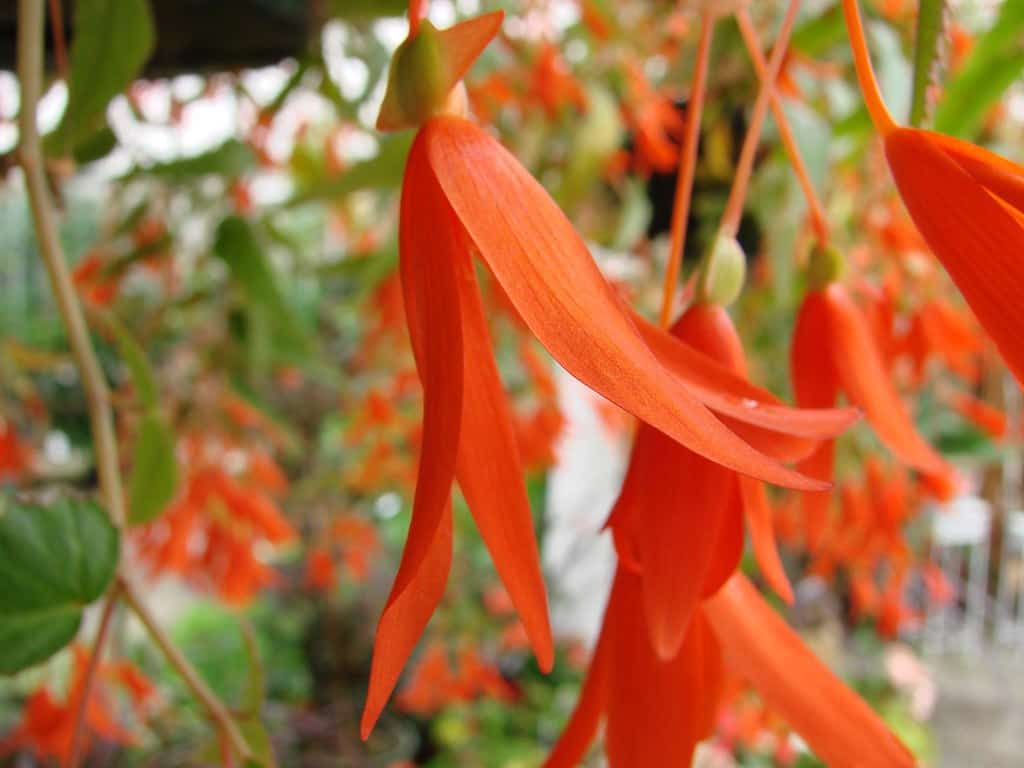
When you search Begonia boliviensis, you find different varieties. But the one that stands out is Begonia bonfire, also known as the Santa Cruz.
The plant looks beautiful, growing as indoor plants in a hanging basket. The genus Begonia is drought-tolerant foliage that you can grow in the garden even with minimal watering.
There are over thousands of begonia species including climbers, herbs, and shrubs. Most of these begonia plants are evergreen, and the leaves have a waxy texture. The flowers are small in pink, white, or red-orange.
You find different groups of begonia. Some are cane-like, rhizomatous, tuberous, shrub-like, fibrous-rooted, trailing, and thick-stemmed plants.
They are native to Southeast Asia, Africa, and South & Central America.
Bonfire Begonia Care

The Boliviensis Begonia is an award-winning plant that is not fussy and requires minimal winter care.
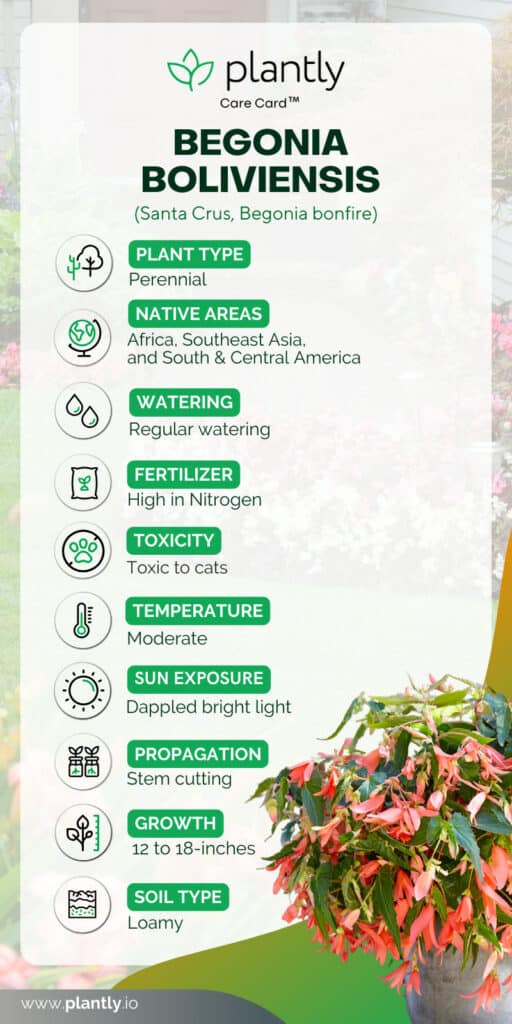
One thing you will appreciate about the Begonia boliviensis is the gorgeous display of color from spring to summer. So here’s how to make your plant vibrant and blooming.
Best Potting Mix for Indoor Begonia Plants
The ideal choice for Begonia boliviensis is a loamy, well-draining soil formulated for houseplants. These potting mediums have vermiculite, peat moss, or perlite.
This perennial enjoys an acidic soil of 6.1 to 6.5 or even a neutral one of 6.6 to 7.5 as it can tolerate vast pH levels.
Still, a neutral to acidic one that remains moist and well-drained works best for begonia growth.
Ideal Lighting is Partial Shade
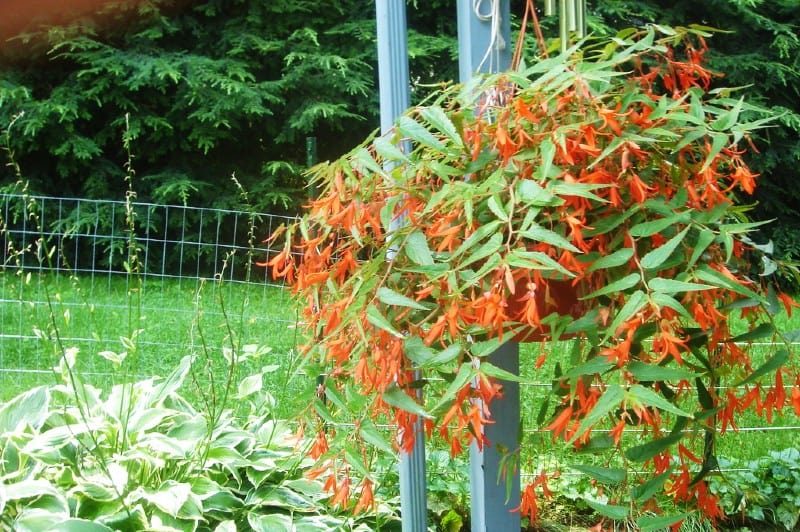
The colorful plant will thrive best in partial shade compared to other Begonia species that flourish in the full sun. We do not recommend exposing your Santa Cruz begonia to direct sun as it can scorch its delicate leaves.
Hence, you can place your plant in filtered light at a southwest-facing window or on the patio where it gets partial sun. But if you grow them as outdoor plants, provide them with partial shade. It could be under a tree canopy.
Watering Needs for Begonias
Remember that begonias are mostly drought-tolerant. So, please try not to overwater them as it can lead to fungal infections like root rot. We recommend checking the soil to see if the top two inches are dry before watering again. The important thing is to provide your tropical beauty with water when it needs it.
Preferably use lukewarm water with a low chlorine content to prevent toxicity and temperature shock. If you do not have distilled water, it helps to leave the tap water standing for 24 hours to allow the chlorine to evaporate.
Temperature & Humidity Provision
Your Begonia bonfire is a tuberous plant growing in cold-sensitive areas and needs up to 14 hours of moderate temperature and light. Once your plant develops roots, it is best to keep them in temperatures of 56°F to 60°F(14°C to 16°C ).
The recommended day temperatures are between 65°F to 75°F(18°C to 24°C ).

As the growing season ends, you can provide your plant with day temperatures between 56°F to 60°F(14°C to 16°C ) is good enough in a home.
Keep them away from winds and drafts resulting from air conditioners or heaters. Your plant is temperature-sensitive. Furthermore, this plant is a humidity lover and needs high humidity levels ranging between 85% to 95%. Make sure to group your begonia with other humidity-loving plants.
Alternatively, you can give the surroundings of the plants occasional misting or you may use a humidity tray. Just don’t let your loving plant get in direct contact with the water.
Fertilizer Needs for Those Beautiful Male and Female Flowers
For the Begonia boliviensis to display those cheerful blooms, you need to work at it. The best option is to provide your plants with fertilizer.
A suitable feed for your Begonia is a 1:1:1 fertilizer such as a regular powder formula. You can dilute it with water to feed in the growing season of late spring and summer every three weeks.
We recommend lessening the feed-in fall to once a month. When winter arrives, you can cease feeding as it goes into a dormant state.
Propagating Begonia boliviensis

You must agree that the Begonia is one spectacular plant, and you want to make sure you always have one growing in containers. The best way to propagate is using stem cuttings. Here are the detailed steps for you to achieve the best results:
- Select a healthy plant and water it the night before to hydrate the foliage and stems.
- Prepare a receptacle of four inches with equal parts milled coir or peat with perlite.
- Dampen the potting medium leaving it standing so that the surplus water drains.
- Choose stem cuttings with a diameter of 1/4 inch without flowers about six inches long.
- Cut 1/8 inch of a pair of leaves using clean scissors.
Remove the leaves in the lower half and remove any buds or flowers.
- Next, dip the cut end into a rooting powder and remove the excess powder.
- Place the cutting in the potting mix to cover the lower half of the stem.
- Add some water and place in part sun, such as in a window or on the patio.
- You can mist your plant to provide the proper hydration every day.
After two weeks, you should notice the roots growing and can transfer your plant to a bigger pot with more soil after two weeks of root development.
Growth Zone
If you live in the USDA hardy zones 8a to 11b, you can grow the Begonia boliviensis in a hanging basket or container as a perennial.
Potting and Pruning
The good news is that Santa Cruz needs no frequent repotting. Instead, we recommend transplanting your plant into a larger pot every two years. But please make sure you provide your begonia with a soil-less mix with ample drainage and humid conditions to grow.
You only need to prune your Begonias when you see unstable growth or the leaves look dull or infected. Do not over-prune your plant as it can damage the healthy vines.
Other Begonia Species and Varieties
Begonia boliviensis ‘Crackling Fire Orange’
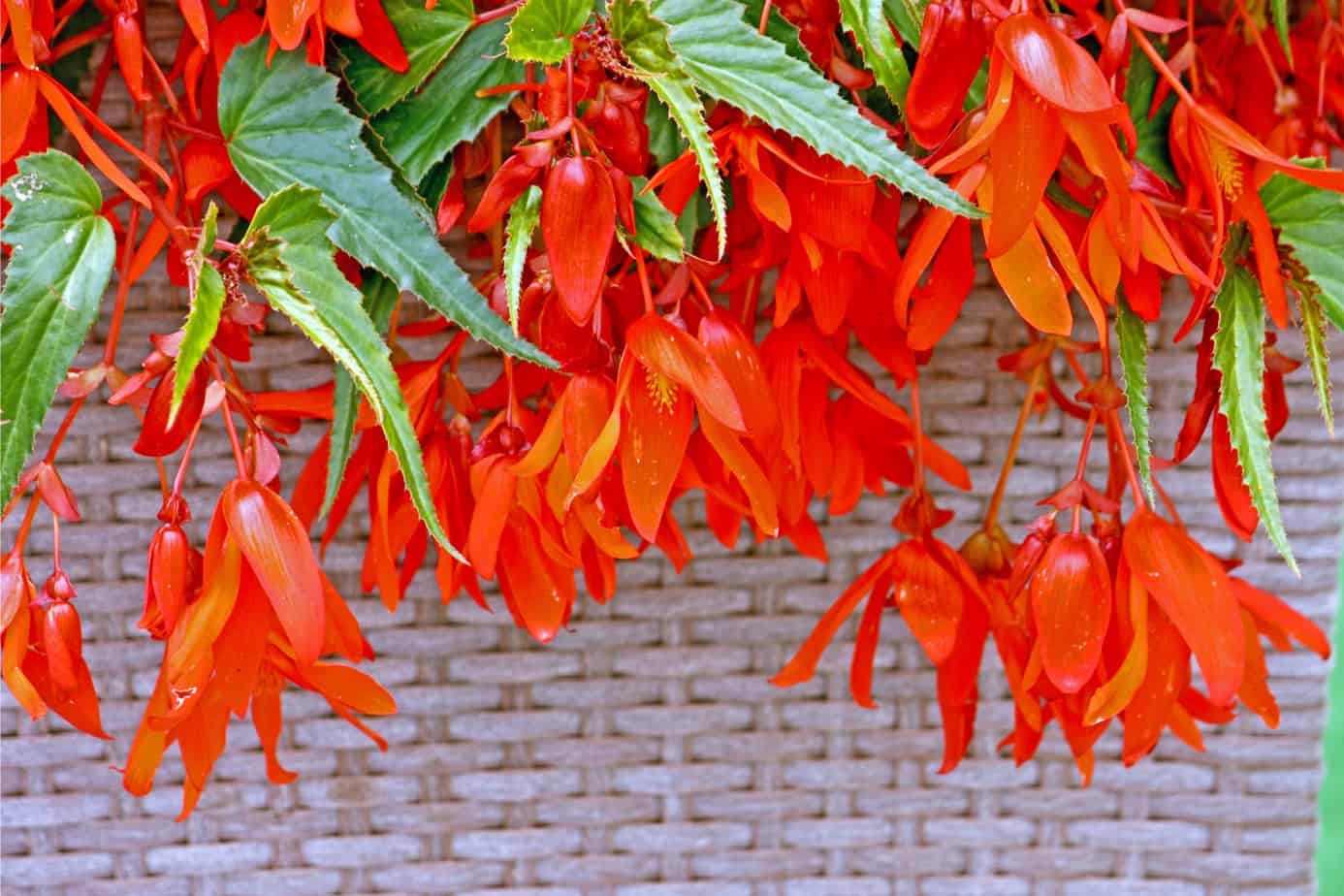
Here we have another tuberous plant that blooms orange flowers in summer right into fall. It grows well placed in full sun with partial shade.
You can also grow them in pots. Before the first frost arrives, you can lift the rhizomes and store them inside moist soil.
Begonia dregei
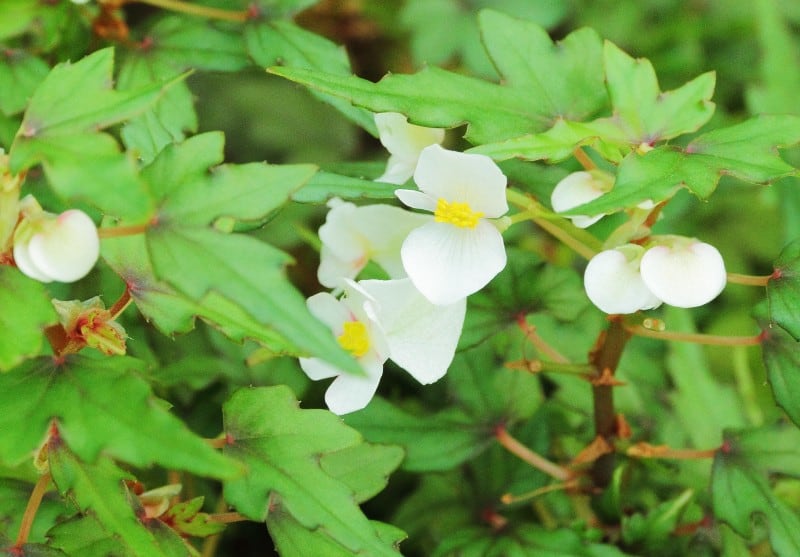
It is a stunning herbaceous shade living plant and even makes a fabulous indoor display grown in a pot. The evergreen you can grow from cuttings and seed
Begonia brevirimosa

The plant will make you look twice with its botanical art leaves. The foliage grows in a shrub-like pattern up to 18-inches.
Begonia boliviensis Plant Diseases & Pests
Here are the common diseases and pests that may cause trouble to your begonia plant.
Powdery Mildew
The fungal disease appears when you expose your plants to very high humidity or dry conditions for a long time.
You first notice an ash-grey or white film forming on the upper and lower surfaces of the foliage. The disease prevents new growth and can lead to blackening leaves. Another concern is the buds will not open. But you can solve the problem by spraying your plant with an insecticide.
Aphids
These insects form clusters on the young shoots or buds on the underside—furthermore, the foliage twists upon itself and restricts new growth.
Yet, that is not all; the insects can produce a substance looking like honeydew resulting in mold fungus. For an immediate fix, an insecticidal spray help with the wash of your plant.
Whiteflies
These flies disrupt the health of Santa Cruz and other Begonias. The best way to check for such an infestation is to shake the foliage as they hide and start swarming around.
These flies feed on the nutrients and leave a substance behind, looking like honeydew. Using insecticidal sprays helps solve the problem.
Slug and Snails
While it is not a frequent problem, you can notice occasional attacks from these critters. Still, they feed on decaying stems and leaves.
If you notice silvery trails looking like gold dust with holes in the leaves, remove decorations placed near your plant as they use it for shelter during the day.
Other Growing Checklist
When growing your Begonia boliviensis, provide horizontal airflow to help prevent diseases. You can pinch your plants one week after propagation leaving three nodes but try to avoid it from developing up to five nodes as it can lead to your plant is dormant.
Keep your plant in dappled sun and water when needed to keep them happy.
Frequently Asked Questions
The plant is tuberous as it springs from the rootstock reaching heights up to 18-inches. You find the flowers in pairs or even threes on a short stem of the lanceolate leaves in red-orange color with four-pointed segments.
You can overwinter the plant when grown in a pot to bring indoors. Then, when the foliage dies back in fall, you can cut the stems and store them in an unheated spot in the home. Once spring arrives, you’ll notice tiny buds showing. That’s the signal that you can take them outside.
But there is a process of bringing your plant indoors from the garden:
- First, make sure your plant is free from diseases and insects.
- If your Begonia grows in the shade, try not to expose them to bright light indoors as it can burn the leaves even in winter.
- Also, provide your plant with humidity inside by misting them or placing them with other houseplants.
- Or you can remove the tubers from the pot and leave them to dry, allowing the stems to fall off. Then you can place them in sacks with labels to plant in spring.
Tuberous Begonias growing in zones three to seven will not survive cold temperatures. When the growing season ends, you can move the pot indoors before it starts to frost. Do not water your plant and leave them to die back.
Place the pots in a dark place, or if grown in the garden, wait until after a light frost and dig the tubers up. Leave the plant lying in a warm place, and after a couple of weeks, pull away from the tuber. Wrap each rhizome in newspaper or paper bags.
Store them in a dark yet dry place, and when warmer climates arrive, you can plant them again. If you live in warmer temperatures from zone eight to eleven, you can leave them in the ground. But try to prevent the tubers from getting too wet.
Begonias are not rare plants, and you can find them at a garden center or online plant store. Good news because there’s no need to rush out and look for one, as you can get this tropical plant here at Plantly.
Whether you want to buy, sell, or simply reach out to other plant enthusiasts, Plantly is the right place to be!


